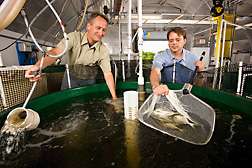Recirculating systems for warm-water marine fish developed by USDA scientists

U.S. Department of Agriculture (USDA) scientists have developed water recirculating systems for warm-water marine fish that have a number of advantages over pond systems. Using recirculated water optimizes fish growth and reduces the incidence of pathogens and disease, conserves water and removes animal wastes. These systems can potentially provide a continuous supply of fresh, healthy fish to consumers near or far from coastal areas.
Agricultural engineer Timothy Pfeiffer, who works for USDA's Agricultural Research Service (ARS) at the agency's Harry K. Dupree Stuttgart National Aquaculture Research Center in Stuttgart, Ark., conducts his research at the Aquaculture Park of the Florida Atlantic University/Harbor Branch Oceanographic Institute in Fort Pierce, Fla. ARS is the principal intramural scientific research agency of USDA, and this work supports the USDA priorities of promoting international food security and agricultural sustainability.
In recent studies, Pfeiffer looked at Florida pompano to determine the fish's response to low-salinity water at high density in recirculating systems. Pompano is a high-value, fast-growing fish found in waters along the U.S. seaboard as far north as New England, and as far south as the Gulf of Mexico all the way to Brazil. Pompano can attain a length of up to 12 inches in the first year of life.
Pfeiffer compared high-head versus low-head pumping systems for pompano production to determine energy requirements and the number of fish that could be maintained in the system. High-head systems use high-pressure centrifugal pumps, and low-head systems use low-pressure axial flow propeller pumps.
Pfeiffer found that the use of low-head pumps with proper system plumbing, minimal bends in the pipe, and larger diameter pipes requires up to 30 percent less energy than a high-head centrifugal pump system, making the enterprise more sustainable.
Pfeiffer also investigated the stocking density of fish in tanks. Traditional pond culture without water recirculation generally operates at densities of 0.005 to 0.007 pounds of fish per gallon of water. Pfeiffer was able to maintain a rate as high as 0.5 pounds of fish per gallon of water.
Provided by USDA Agricultural Research Service
















